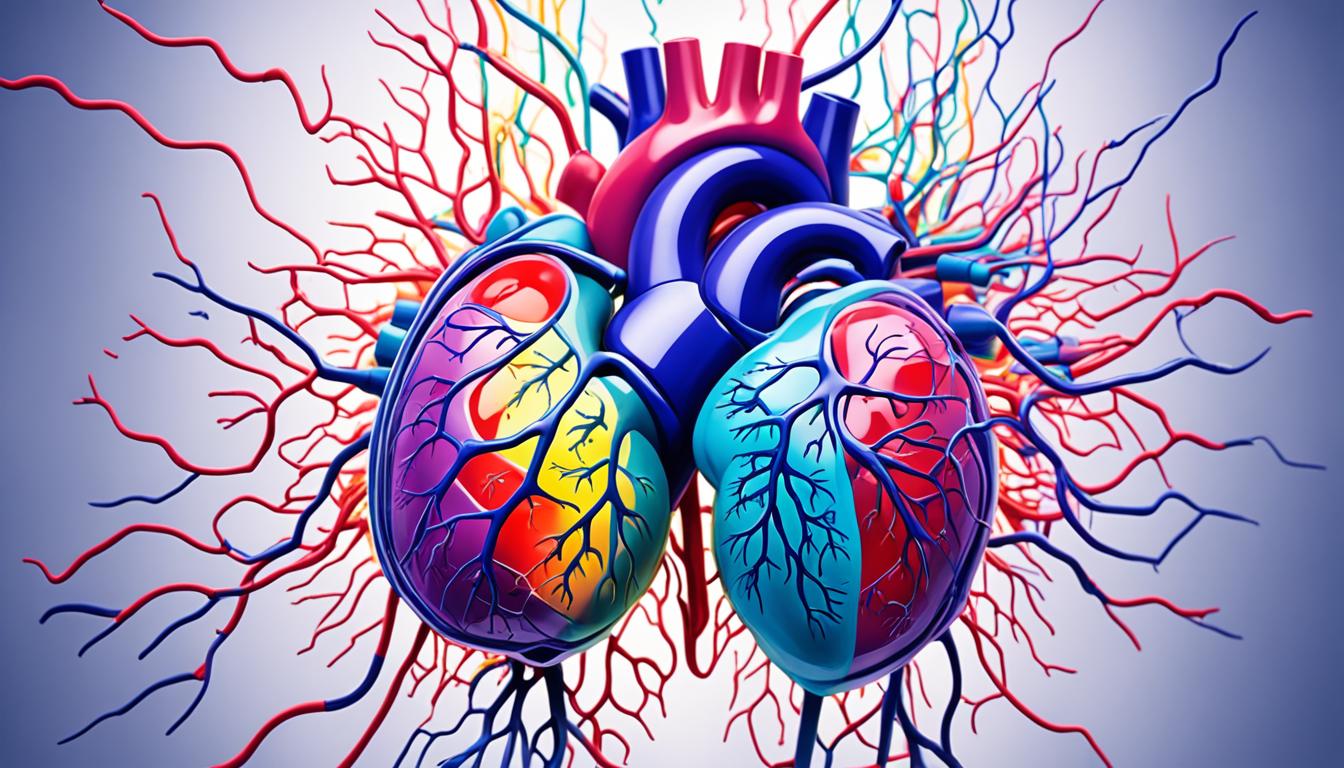Ventricular fibrillation is a serious heart issue where the heart beats abnormally. It can lead to sudden cardiac arrest. This condition is a type of heart arrhythmia and needs quick medical help. The heart’s electric signals become messy, causing the heart’s lower chambers to shake instead of pumping well.
This shaking can cut off oxygen to the body’s organs and tissues, causing serious harm. Conditions like heart disease, Brugada syndrome, and electric shock can disrupt the heart’s electric signals. This disruption leads to ventricular fibrillation.
Doctors usually diagnose ventricular fibrillation with a test called an electrocardiogram (ECG). It’s a simple and painless test that checks the heart’s electric activity. If someone is in fibrillation, the ECG will show abnormal patterns.
The best treatments for ventricular fibrillation include CPR and defibrillation. CPR keeps the blood and oxygen moving until the heart’s rhythm can be fixed. Defibrillation, a shock to the heart, helps reset the rhythm. It’s important to get to the hospital quickly during a ventricular fibrillation episode. Fast help raises the survival odds by a lot.
Key Takeaways:
- Ventricular fibrillation is a life-threatening condition characterized by abnormal heart beats.
- Underlying conditions such as coronary heart disease, valvular heart disease, and cardiomyopathy can cause ventricular fibrillation.
- Diagnosis is typically done through an electrocardiogram (ECG) that shows irregular unformed QRS complexes.
- The primary treatment for ventricular fibrillation is cardiopulmonary resuscitation (CPR) combined with defibrillation.
- Immediate medical treatment is vital to improve the chances of survival when faced with ventricular fibrillation.
Stem Cell Therapy for Ventricular Fibrillation
Stem cell therapy is now offering hope in treating ventricular fibrillation. It focuses on using different stem cells like hESCs, hiPSCs, and MSCs to better heart health in patients with this dangerous issue.
hESCs and hiPSCs can change into heart muscle cells called cardiomyocytes. These cells aid in the heart’s contraction. The idea is to place these stem cells in the heart’s damaged parts to help make them function normally again.
MSCs come from places like bone marrow or fat tissue. They help by releasing substances that support tissue healing and reduce swelling. This aids in improving the heart’s work in ventricular fibrillation patients.
The Potential Arrhythmogenic Risk
Using hESCs and hiPSCs in stem therapy raise a key issue: the potential for causing heart rhythm problems. Cardiomyocytes from these stem cells may act in a way that promotes these issues.
Although stem therapy shows great promise, tackling such risks is crucial. Efforts are being made to mature the cardiomyocytes from hESCs and hiPSCs. This would reduce the risk of heart rhythm problems and enhance patient outcomes.
Research aims to fully understand and lower the risk of heart rhythm problems while boosting the therapy’s benefits in ventricular fibrillation cases.
Challenges and Solutions in Stem Cell Therapy for Ventricular Fibrillation
Using stem cell therapy for ventricular fibrillation comes with its hurdles. A big one is the risk of abnormal heart rhythms. This risk is from using certain types of heart cells made from stem cells. These cells act young which can cause heart rhythm problems.
Another challenge is getting the stem cells to work well with the heart’s own cells. It is vital they fit in and help the heart’s electrical system. This step is key for the therapy to give lasting results. Improving the heart’s electrical system is just as important.
Many experts are working hard to solve these issues and make stem cell therapy safer and better for the heart. They aim to make these heart cells more like mature heart cells. This can cut down on the risk of heart rhythm issues.
Besides, making sure the stem cells match well with the heart’s cells can boost their power to heal. Researchers are looking at new ways to improve how the heart’s electricity flows. They’re trying out with cell engineering and mixing stem cell therapy with other treatments.
Challenges:
- Arrhythmogenic risk associated with hESC-CMs and hiPSC-CMs
- Ensuring effective integration with host cells
- Establishing proper myocardial electrical conduction
Solutions:
- Improving maturity and electrophysiological properties of hESC-CMs and hiPSC-CMs
- Optimizing cell engraftment techniques
- Enhancing electrical conduction in the heart through innovative approaches
By tackling these issues with smart solutions, we can make stem cell therapy for ventricular fibrillation better and safer. The progress in this field promises new hope for treating this severe heart condition.
Conclusion
Stem cell therapy shows great promise in treating ventricular fibrillation, a dangerous condition with abnormal heart beats. There are some challenges, like risks of causing irregular heartbeats. Yet, scientists are working hard to make stem cell therapy safer and more effective.
This therapy focuses on making the heart cells from stem cells act more like mature heart cells. It also works on making sure these new cells are accepted well by the body. Both these steps are vital for treating ventricular fibrillation.
Research in using stem cells to treat the heart continues to move forward. There is hope that with these advancements, we could see major changes in treating heart conditions like ventricular fibrillation. This could lead to better health outcomes for patients. Stem cell therapy really shines a light on the future of heart health treatments.

